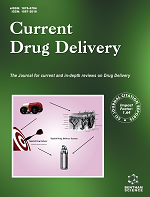- Home
- A-Z Publications
- Current Drug Delivery
- Previous Issues
- Volume 12, Issue 4, 2015
Current Drug Delivery - Volume 12, Issue 4, 2015
Volume 12, Issue 4, 2015
-
-
Immunostimulant Properties of Chemical Delivery Systems in Vaccine Development
More LessAuthors: Sahar Hosseinzadeh and Azam BolhassaniOne approach to improve the vaccine quality is the incorporation of immunomodulators and/or adjuvants with modified delivery systems. The use of delivery systems especially chemical carriers is a promising strategy in the prevention and treatment of infections, cancers, allergies and autoimmune diseases. These systems are able to elicit an effective immune response as well as stability and safety in vaccine developm Read More
-
-
-
Chitosan: A Propitious Biopolymer for Drug Delivery
More LessAuthors: Dibyangana S. Duttagupta, Varsha M. Jadhav and Vilasrao J. KadamScientists have always been interested in the use of natural polymers for drug delivery. Chitosan, being a natural cationic polysaccharide has received a great deal of attention in the past few years. It is obtained by deacetylation of chitin and is regarded as the second most ubiquitous polymer subsequent to cellulose on earth. Unlike other natural polymers, the cationic charge possessed by chitosan is accountable for i Read More
-
-
-
Novel Delivery Systems for Anti-Allergic Agents: Allergic Disease and Innovative Treatments
More LessAuthors: Carla M. Lopes, Pedro B. Coelho and Rita OliveiraAnti-allergic agents are used to treat a great variety of diseases which usually involve an inflammation reaction. These compounds act by inhibiting the release and the effects of inflammatory mediators (e.g. histamine) in the target tissue. The purpose of anti-allergy therapy is to deliver the drug to its local of action in a therapeutic concentration, minimizing the undesired side effects. In order to solve some of the anti-allergic age Read More
-
-
-
Preparation, characterization and in vitro release of zein-pectin capsules for target delivery
More LessAuthors: Wai-Wa Tang, Fangyuan Dong, Ka-Hing Wong and Yi WangTargeted drug delivery has been the interest of many researchers to improve drug efficiency and reduce side effects. Because of the potential toxicity and contamination problems of the current gelatin capsules, plant derived materials are selected for the developments of capsules for drug delivery systems. The objective of this work is to develop a target drug delivery system using zein and pectin. Different ratios of zein and Read More
-
-
-
Biochemical Characterization of GM1 Micelles-Amphotericin B Interaction
More LessIn this work a thorough characterization of the GM1 micelle-Amphotericin B (AmB) interaction was performed. The micelle formation as well as the drug loading occurs spontaneously, although influenced by the physicochemical conditions, pH and temperature. The chromatographic profile of GM1-AmB complexes at different molar ratios shows the existence of two populations. The differential absorbance of GM1, monomeric Read More
-
-
-
Physically Cross-linked Hydrogels of β -cyclodextrin Polymer and Poly(ethylene glycol)-cholesterol as Delivery Systems for Macromolecules and Small Drug Molecules
More LessAuthors: Shaaban K. Osman, Ghareb M. Soliman and Saleh Abd El RasoulAn injectable hydrogel based on the inclusion complexation of polymerized β-cyclodextrin (pβ-CD) and cholesterol terminated poly(ethylene glycol) (PEG-chol) was developed and used as a delivery system for both macromolecules and small drugs. The hydrogel was characterized by different analyses including X-ray diffraction, differential scanning calorimetry and scanning electron microscopy. The effects of pβ-CD/PEG-chol r Read More
-
-
-
Formulation and Evaluation of Different Floating Tablets Containing Metronidazole to Target Stomach
More LessAuthors: Zhiao C. Loh and Amal A. ElkordyThe purpose of this study is to formulate and develop tablets dosage form containing Metronidazole which has swelling and floating properties as a gastroretentive controlled-release drug delivery system to improve drug bioavailability. Fifteen different formulations of effervescence-forming floating systems were designed using HPMC K15M, xanthan gum, co-povidone, Eudragit® RL PO, pluronic® F-127 and/or polypropylene Read More
-
-
-
Production of β -cyclodextrin from pH and Thermo Stable Cyclodextrin Glycosyl Transferase, Obtained from Arthrobacter mysorens and Its Evaluation as a Drug Carrier for Irbesartan
More LessCyclodextrins (CDs) are carrier molecules produced by cyclization of α-1,4-glucans by Cyclodextrin Glycosyl Transferase (CGTase). These torus shaped molecules have hydrophobic cavity and hydrophilic shell making them useful in pharmaceutical, food, textile, pesticide and cosmetic industries. In this study, culture conditions for the production of CGTase by organism belonging to Arthrobacter genus obtained from a p Read More
-
-
-
Boswellia carterii Liquisolid Systems with Promoted Anti-inflammatory Activity
More LessBoswellia carterii (BC) Birdwood oleogum resin is an ancient remedy of inflammation processes known since Ancient Egyptian time. Of boswellic acids, 3-acetyl-11-keto-β-boswellic acid (AKBA) is the most potent anti-inflammatory active principle. Liquisolid systems of the biologically active fraction of BC oleogum resin were prepared for improving dissolution properties using low dose oral delivery to achieve enhanced anti-i Read More
-
-
-
Development and Characterization of Spray Dried Microparticles for Pulmonary Delivery of Antifungal Drug
More LessAuthors: Divita Mathpal, Tarun Garg, Goutam Rath and Amit K. GoyalInvasive pulmonary aspergillosis is a life threatening fungal infection mainly caused by Aspergillus species. Available treatment strategy against pulmonary aspergillosis is having very limited applicability, due to its toxicity and low circulation half-life. Pulmonary drug delivery is one of the strategies that can minimize these pitfalls. In the present study, polymeric and lipidic nanoparticles of amphotericin B were prepared by Read More
-
Volumes & issues
-
Volume 22 (2025)
-
Volume 21 (2024)
-
Volume 20 (2023)
-
Volume 19 (2022)
-
Volume 18 (2021)
-
Volume 17 (2020)
-
Volume 16 (2019)
-
Volume 15 (2018)
-
Volume 14 (2017)
-
Volume 13 (2016)
-
Volume 12 (2015)
-
Volume 11 (2014)
-
Volume 10 (2013)
-
Volume 9 (2012)
-
Volume 8 (2011)
-
Volume 7 (2010)
-
Volume 6 (2009)
-
Volume 5 (2008)
-
Volume 4 (2007)
-
Volume 3 (2006)
-
Volume 2 (2005)
-
Volume 1 (2004)
Most Read This Month
Article
content/journals/cdd
Journal
10
5
false
en

Most Cited Most Cited RSS feed
-
-
Preface
Authors: Deng-Guang Yu and He Lv
-
- More Less

